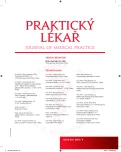Chloroquine retinopathy: case report and recommendations for screening
Authors:
B. Kousal; Z. Dubská 1; A. Beňová 1; P. Diblík 1; H. Langrová 1; B. Kalvodová 2 1
Authors‘ workplace:
Univerzita Karlova v Praze, 1. lékařská fakulta a Všeobecná fakultní nemocnice v Praze, Oční klinikaPřednostka: doc. MUDr. Bohdana Kalvodová, CSc.
1; Univerzita Karlova v Praze, Lékařská fakulta v Hradci Králové, Oční klinikaPřednosta: prof. MUDr. Pavel Rozsíval, CSc., FEBO
2
Published in:
Prakt. Lék. 2013; 93(4): 181-185
Category:
Case Report
Overview
Long-term usage of the antimalarial drugs chloroquine and hydroxychloroquine has a retinotoxic effect. Toxicity is mainly dependent on the cumulative dose of medication and may persist even after treatment has been concluded. Eye examination comprising dilated fundus evaluation, testing the central 10 degrees of the visual field, spectral domain optical coherence tomography, fundus autofluorescence and multifocal electroretinography help with early detection of functional changes. Immediate discontinuation of these medications may reduce the risk of visual impairment. Regular ophthalmologic evaluation, interdisciplinary cooperation and patient education are important to prevent late ocular complications.
Keywords:
chloroquine – hydroxychloroquine – retinopathy – screening
Sources
1. Bonanomi MTBC, Dantas NC, Medeiros FA. Retinal nerve fibre layer thickness measurements in patients using chloroquine. Clin Experiment Ophthalmol 2006; 34 : 130–136.
2. Farrell DF. Retinal toxicity to antimalarial drugs: chloroquine and hydroxychloroquine: a neurophysiologic study. Clin Ophthalmol 2012; 6 : 377–383.
3. Hallberg A, Naeser P, Andersson A. Effects of long-term chloroquine exposure on the phospholipid metabolism in retina and pigment epithelium of the mouse. Acta Ophthalmol (Copenh) 1990; 68 : 125–130.
4. Chen E, Brown DM, Benz MS, et al. Spectral domain optical coherence tomography as an effective screening test for hydroxychloroquine retinopathy (the “flying saucer” sign). Clin Ophthalmol 2010; 4 : 1151–1158.
5. Ingster-Moati I, Crochet M, Manchon E, et al. Analysis of 925 patients on long-term hydroxychloroquine or chloroquine treatment: results of ophthalmological screening. J Fr Ophtalmol 2004; 27 : 367–373.
6. Lyons JS, Severns ML. Using multifocal ERG ring ratios to detect and follow Plaquenil retinal toxicity: a review: Review of mfERG ring ratios in Plaquenil toxicity. Doc Ophthalmol 2009; 118 : 29–36.
7. Maksymowych W, Russel AS. Antimalarials in rheumatology: efficacy and safety. Sem Arthritis Rheum 1987; 16 : 206–221.
8. Marmor MF, Kellner U, Lai TYY, et al. Revised recommendations on screening for chloroquine and hydroxychloroquine retinopathy. Ophthalmology 2011; 118 : 415–422.
9. Michaelides M, Stover BN, Francis PJ, et al. Retinal toxicity associated with hydroxychloroquine and chloroquine. Arch Ophthalmol 2011; 129(1): 30–39.
10. Pavelka K. Farmakoterapie revmatických onemocnění. Praha: Grada Publishing 2005; 65–74.
11. Smith JL. Chloroquine macular degeneration. Arch Ophthalmol 1962; 68(2): 186–190.
12. Wolfe F, Marmor MF. Rates and predictors of hydroxychloroquine retinal toxicity in patients with rheumatoid arthritis and systemic lupus erythematosus. Arthritis Care Res (Hoboken) 2010; 62 : 775–784.
Labels
General practitioner for children and adolescents General practitioner for adultsArticle was published in
General Practitioner

2013 Issue 4
Most read in this issue
- Chloroquine retinopathy: case report and recommendations for screening
- The female and the male brain
- Dengue fever
- Nutritional imunology: modulation of immunity by components of nutrition
